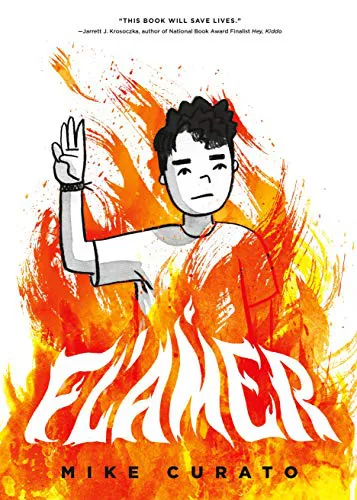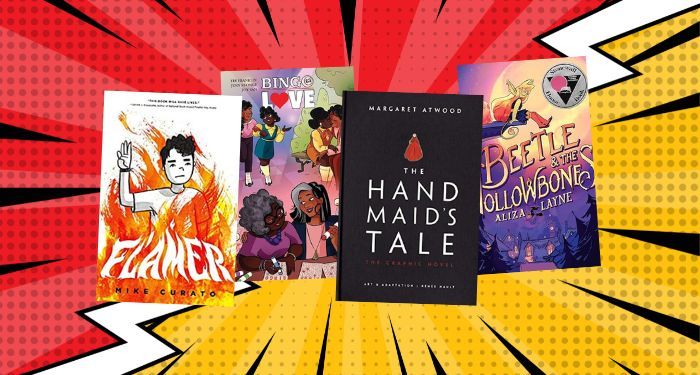This content contains affiliate links. When you buy through these links, we may earn an affiliate commission.
Comics have always been among the most banned books. Since their rise in popularity during the 1940s and 1950s, parents have targeted the format for its appeal to young readers. Much of this came to a head in the 1950s, when McCarthyism in the US spread the fear of communism. The government wanted to ensure that the young people in the country were protected from outside influences. We know, of course, the young people in their minds were cishet, white, Christian males. White middle-class populations grew after World War II, and young people within this demographic found themselves with more access to leisure time and to consumer goods, thanks in part to more teenagers taking on part-time work outside of the house. In 1953, the United States Senate Judiciary Committee established the Subcommittee on Juvenile Delinquency to investigate what could be done to help the youth. But that subcommittee’s work had a major focus: comic books.
There’s a long history here, and so much of the hearings and “experts” who spoke on the damage comics caused young readers mirror and echo today’s rhetoric. Check out the work of one of the subcommittee’s witnesses, Frederic Wertham, whose Seduction of the Innocent argued that comic book depictions of drug use, sex, and violence made those behaviors “appealing” to young readers, leading to increased delinquency. This book and the hearings were directly linked to the development of the Comics Code Authority, a body developed within the comics industry to self-censor what was published.
Much of what Wertham argued would later be debunked by researchers and experts in the field of literacy and comics. But the damage was done. Communities across the country were caught up in the manufactured panic, which led to public burnings of comics in several states, including West Virginia (young people were encouraged by their church to collect comics and at the end, they lit them on fire, tossing an issue of Superman on top) and New Jersey (where Cub Scouts competed to collect the most naughty comics and the winner got to light the pile ablaze).
Those ideas persisted though and as libraries began to make more concerted efforts to collect comics in the ’00s, more demands to ban the books emerged during that era of censorship. The attacks were widespread, though because social media and the internet were not used the same way they are now, knowledge and preservation of that era is not as strong as it is in today’s censorship moment.
Comics are a target because it’s a medium that requires a unique literacy to understand. They make for easy targets because a person who has been infected by right-wing rhetoric can print the pages collected on Moms For Liberty’s BookLooks database and claim they’re inappropriate without any context about the where, why, or how of that image within the book itself. Unfortunately, these people are not interested in learning the literacy, and by spreading these images without context, they inflame other people who don’t have the time or capacity to develop that literacy and actually “do their own research” on the matter. Comics are a collaborative dance between the words and the art. Young people with access to and exposure to comics are honing crucial intellectual skills while also enjoying creative, clever, fun, and educational stories.
Since 2021, comics have been at the top of the list for books being banned in America. Many of these comics are far from new–indeed, the average age of banned books (i.e., their publication year) right now is between 13 and 15 years old. It’s worth taking a peek at the most banned comics since 2000 and seeing where and how they’re simply copy and pasted in 2024, with the addition of primarily queer-focused comics and comics by creators of color.
These are some of the many reasons why “Read a Banned Comic” is Task #13 for the 2024 Read Harder Challenge. By reading banned comics, you hone those crucial literacy skills both when it comes to the comics format and when it comes to navigating the current landscape of book banning.
Let’s take a look at a handful of contemporary banned comics to understand what they’re actually about. I’ve included comics for all age groups here, from the youngest readers to the most mature. You’re going to not only find one comic here to help you complete Task 13. You’re going to want to read every single one of these.


Bingo Love #1 by Tee Franklin, with art by Jenn St-Onge, Joy San, and Genevieve FT
Hazel and Mari meet in 1963 during church bingo. Of course, they couldn’t be open about their feelings for each other at the time, so they followed the socially acceptable path of marrying men and having children. But when they meet again in their 60s, again at church bingo, they realize they cannot hide those feelings any longer.
This comic was banned in Escambia County Schools in Florida in their sweeping removal of 1600 titles.


Flamer by Mike Curato
Aiden Navarro is at summer camp before the start of junior high. It’s an intense summer of hanging out with his friends, navigating bullies desperate to make him feel bad about himself as a half-Asian boy, and coming to terms with the fact he might be gay.
One night, when Aiden kisses his best friend and campmate, things shift immediately. Has he forever lost the trust of his friend Elias? Did that kiss mean anything romantic? Was it an accident?
This is a moving, heartfelt story about traversing that tricky space between what faith might tell you is right, what it might tell you is a sin, and how you come to accept yourself as you are.
Flamer is one of the most banned comics nationwide, ranking #5 on the American Library Association’s list of top 10 most banned books in 2023.
All Access Subscribers: your bonus content is below!
If you’re angry, you should be. I urge you that if you can and it is safe to do so, take action. It is not hard to get involved. Here’s a straightforward guide to how to get involved in anti-book ban work in 2024.
Have a favorite banned comic, whether a contemporary read or one from earlier book ban panics? Tell us about it in the comments.
The comments section is moderated according to our community guidelines. Please check them out so we can maintain a safe and supportive community of readers.

